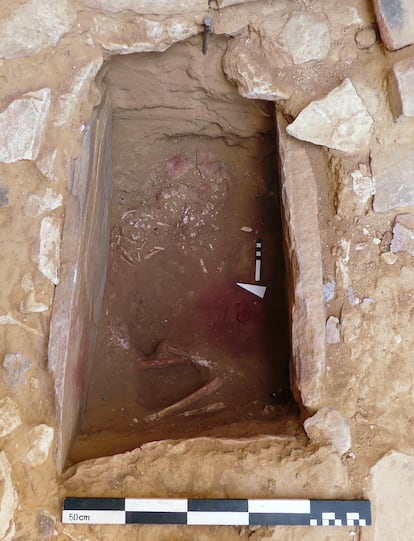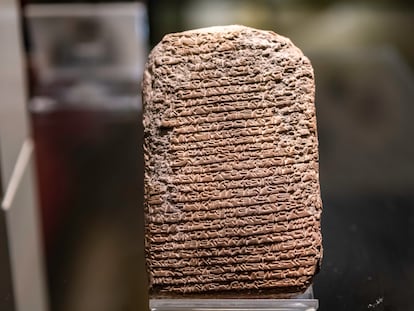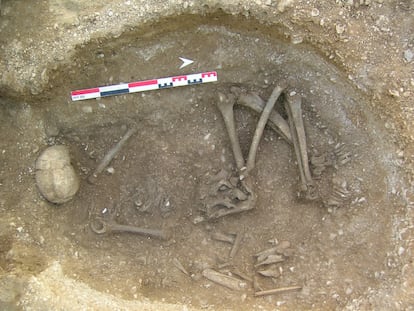A mysterious necklace with 2,500 ornaments buried next to a child reveals a complex culture from 9,000 years ago
The analysis of the findings from an archaeological site in Jordan sheds light on the funerary symbology of early peasant societies, which traded goods and created rituals to bid farewell to the dead
Over 9,000 years ago in a remote area of present-day Jordan, a tribe decided to bury a recently deceased child in style. Rather than a contemporary family ceremony of discreet mourning, the funeral rite probably brought together all the inhabitants of the Ba’ja village, and perhaps even people from the surrounding area. They built a small tomb for the child made of vertical stones and buried the minor under other ones, which had been cut and worked, in the basement of an extant house with several floors. The burial culminated with the Neolithic society placing an elaborate body ornament made of thousands of beads on the corpse; the child was approximately eight years old, and the sex is unknown. The presence of ochre scattered all over the body of the deceased in the tomb—especially the mound of that reddish pigment placed next to the child’s legs—indicates that it was a ritual.
In addition to demonstrating the tribe’s intentionality in bidding farewell to the child, the complexity of the ritual highlights the importance of the funeral in the social life of these early Neolithic farmer-herders. That is the conclusion that Hala Alarashi, of the Spanish Research Council’s Center for the Archaeology of Social Dynamics, reached in her study, which the academic journal PLoS ONE published today. Her international and multidisciplinary team has investigated the archaeological site of Ba’ja in Jordan and reconstructed the necklace. “I have studied many Neolithic collections all over the Near East, the Nile and the Horn of Africa, and I have never seen this,” explains Alarashi, who is also affiliated with to the Côte d’Azur University in Nice, France. According to the researcher, the use of pearls and shells from the Red Sea, along with their ornamental elaboration with patterns done at a highly professional level, is “characteristic of this area of the eastern Mediterranean; [it’s] typical of the Petra region.” Alarashi adds that “they [were] people who really [knew] what they [were] doing; there was a very clear idea.”
The discovery of the necklace in the tomb, which is dated between 7,400 and 6,800 BC, helps researchers to understand the importance of symbols in the transmission of status and identity within the Neolithic culture. The pendant has over 2,500 stones in different colors and of disparate provenance, indicating that its creation “had another meaning beyond the personal adornment that we attach to it today; it was not pure decoration,” Alarashi says.

The exotic nature of the raw materials—with elements that can be traced to areas far from Jordan—used to manufacture the necklace provides unprecedented information about how this already-sedentary tribe might have functioned. According to the researcher, the fact that the necklace combines such varied material is spectacular: “The two fossil amber beads that we have analyzed [are] a very important finding because, until now, we had not found that [material] so far back in time; amber was associated with more recent cities like Mesopotamia or Pharaonic Egypt.”
The scientist highlights childhood’s importance in this tribe’s culture, since it made such a symbolically complicated artifact in economic and technical terms, as well as in its conception and artistic design. Complex layers of meticulous work reveal that the Ba’ja community was a highly developed society. It had artisans, farmers and the trade networks necessary to obtain the most desired materials from other regions. In other words, it had everything it needed at the time to elaborate a funerary necklace and deposit it next to the corpse. That action could be understood as “getting rid of it on the spot, according to our current standards,” Alarashi says ironically, smiling via videoconference. But, she clarifies, the society that buried the child with full honors “may not have perceived economic wealth as we do today.” The researchers’ reconstruction of the original necklace is now on display at the Petra Museum in southern Jordan.

For that reason, the burial must have been a special public event, the researchers explain in their publication, which also justifies the tomb’s laborious construction. It was “a moment to gather people to share emotions and remember…this individual,” the archaeologist says. The author is very careful when mentioning the buried child’s biological characteristics because it is impossible to definitively determine the minor’s sex: “We have tried [to do so] with DNA analysis, but [the results] have not been satisfactory because the collagen has not been preserved.” In their research article, the authors note that the area is very arid and the meters of sediment under which the body is buried have corroded the biological and bone tissues, which caused the corpse to fall apart quickly.
I have studied many Neolithic collections all over the Near East, the Nile and the Horn of Africa, and I have never seen this beforeHala Alarashi of the Spanish Research Council and Côte d'Azur University
Manuel González, a professor emeritus at the University of Cantabria (Spain), praises the finding: “[The fact] that a child [was] buried with honors shows that 9,000 years ago the tribe [there] already had some kind of social stratification, where the child’s importance [and] prestige, did not depend on their actions or achievements.” The expert in prehistoric times, who was not involved in this research project, emphasizes that “the individual’s personal value was in belonging to a community within that society. That is the most interesting thing.” González, who has worked at other sites in Jordan, believes that this burial reinforced the group’s social cohesion, so the funerary practice was “very important,” much as it is today. He goes on to say: “Relationships in the world of the living [intersected] with that of their forebears and ancestors, much like in many communities today, [where] nationalist heroes, or [heroes] from some seminal battle to which nationalism appeals, serve as acts of cohesion between us… to [build community], we turn to the past to reinforce the bond.”
The researcher believes that the complex process of making the pendant puts an end to the myth that the first sedentary societies were isolated and basic: the “Fertile Crescent [a historical region that includes the territories of the Mediterranean Levant and Mesopotamia] has always been a key transit point between different seas and communication routes, reflecting societies immersed in a wider network of trading goods.” According to González, that was where the Neolithic revolution represented a paradigm shift in social structures: “We don’t realize that for two million years we were hunter-gatherers, [we were] essentially tribal. Only in the last 10,000 years did we start [doing] agriculture and raising livestock, as in the society we are discussing here; in essence, [we became] something else.”
Sign up for our weekly newsletter to get more English-language news coverage from EL PAÍS USA Edition
Tu suscripción se está usando en otro dispositivo
¿Quieres añadir otro usuario a tu suscripción?
Si continúas leyendo en este dispositivo, no se podrá leer en el otro.
FlechaTu suscripción se está usando en otro dispositivo y solo puedes acceder a EL PAÍS desde un dispositivo a la vez.
Si quieres compartir tu cuenta, cambia tu suscripción a la modalidad Premium, así podrás añadir otro usuario. Cada uno accederá con su propia cuenta de email, lo que os permitirá personalizar vuestra experiencia en EL PAÍS.
¿Tienes una suscripción de empresa? Accede aquí para contratar más cuentas.
En el caso de no saber quién está usando tu cuenta, te recomendamos cambiar tu contraseña aquí.
Si decides continuar compartiendo tu cuenta, este mensaje se mostrará en tu dispositivo y en el de la otra persona que está usando tu cuenta de forma indefinida, afectando a tu experiencia de lectura. Puedes consultar aquí los términos y condiciones de la suscripción digital.
More information
Últimas noticias
Imelda Castro, the woman who wants to rule the cartel battleground of Sinaloa
The new victims of the Republican war on Obamacare: Millions hit by soaring health insurance premiums
A country divided on migrant rights: Some US states expand protections while others restrict them
Venezuela authorizes the release of another 87 political prisoners
Most viewed
- David King, chemist: ‘There are scientists studying how to cool the planet; nobody should stop these experiments from happening’
- Reinhard Genzel, Nobel laureate in physics: ‘One-minute videos will never give you the truth’
- Oona Chaplin: ‘I told James Cameron that I was living in a treehouse and starting a permaculture project with a friend’
- Sinaloa Cartel war is taking its toll on Los Chapitos
- The Interoceanic Train, the Mexican alternative to the Panama Canal










































